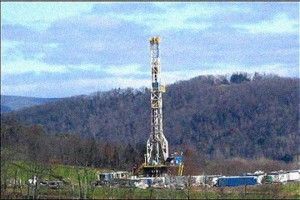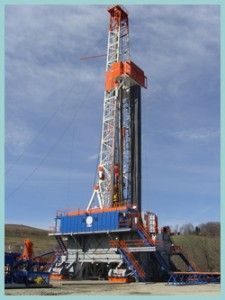
By Chris Reed
The escalating battle over using hydraulic fracturing — better known as fracking — for highly promising oil and natural gas exploration in California isn’t just another front in the state’s long-running war between environmentalists and business interests.
For the journalists who cover the bid of oil giants such as Occidental Petroleum to develop California’s enormous oil shale resource, it’s a test of their honesty.
The stakes are vast for the Golden State. If fracking were allowed, our state’s ravaged economy could enjoy the sort of boom that is lifting the Dakotas, Ohio and other areas around the U.S., a boom that has freed up immense new supplies of natural gas, driven down its cost by 70 percent and helped reduce carbon-dioxide emissions to 1992 levels. California has by far the largest oil shale resource in the U.S. Thankfully, the initial fracking regulations released last week by Gov. Jerry Brown’s administration appear both neutral and thoughtful.
But because the brown energy revolution is so much of a threat to their global push for renewable green energy, environmentalists are feverishly fighting back — even if having much more natural gas in the U.S. energy could help in the fight against global warming.
The narrative that the Natural Resources Defense Council, the Sierra Club and Democratic operatives push is that it is dangerous and entering uncharted new territory to use high-powered streams of water mixed with sand and chemicals to blast away underground rock and reach previously inaccessible oil and natural gas resources. They warn of profound risks to groundwater supplies and of triggering earthquakes.
 ‘Massively’ used in 1970s
‘Massively’ used in 1970s
But the truth is fracking has been around since 1947, and according to a University of Texas study, has been used in the drilling of 1 million wells — yes, 1 million. (In a twist that will only further inflame those on the left who see it as an unholy plot, it was pioneered by Halliburton.)And not only has it been around for 65 years, five presidents ago, fracking was regularly described as being in “massive” use. This is the first few graphs from an 5,300-word article headlined “Massive frac treatments tapping tight gas sands in Uinta basin” in the Jan. 16, 1978, edition of the Oil & Gas Journal:
“Massive hydraulic fracturing (MHF) is giving favorable results in the low-permeability Wasatch- Mesaverde sands in Utah’s Uinta basin where earlier conventional completions gave marginal gas wells.
“As many as 24 sands over a 3,500-ft gross interval are fractured with up to 1 1/2 million lbs. of sand in one continuous treatment using staged or limited-entry techniques.
“Over 90% of the sands perforated are effectively stimulated. The treatments have given an average sevenfold increase on the nine wells stimulated to date.”
An 1,800-word Newsweek article from Oct. 30, 1978, headlined “The New Gas Bonanza,” places fracking at the center of one of the big energy stories of the late 1970s:
“Deep beneath southeastern Louisiana lies a 125-mile geological formation called the Tuscaloosa Trend. Several monstrous drilling rigs soar above the surface, probing nearly 4 miles into the earth for deposits of natural gas. The cost of drilling so deep is enormous — about $5 million for each well — and many producers have been discouraged from making the gamble by the low price of any gas they might find. But when he signs the new energy bill Jimmy Carter may give new life to the Tuscaloosa Trend project and scores of other potentially vast gas discoveries. ‘The gas industry,’ says American Gas Association president George Lawrence, ‘is entering an entirely new era.’
“Such enthusiasm marks a dramatic departure from the mood only eighteen months ago. Then, the Administration’s proposed energy program virtually discounted natural gas as a significant source of energy in the future — a conclusion reached in the light of declining reserves and consumption, falling production and chronic winter shortages. As a result, the Carter strategists recommended that the U.S. continue to cut consumption, that industry switch from gas to coal and that natural gas be saved for the highest-priority consumers.
“But the legislation that finally emerged from Congress earlier this month placed natural gas at the center of the nation’s energy efforts — and during the months of debate, even Administration officials have turned 180 degrees on the issue. Under the new law, Federal price ceilings on newly discovered gas will be lifted by 1985. In anticipation of higher prices, gas men are already drilling at record levels. And the real bonanza may lie in exotic new sources. As gas prices rise, experts say, both independent drillers and major energy companies seem more likely to commit the huge investments required to tap gas trapped in deep basins or in tight sand, rock and coal formations.”
What was used to tap some of these exotic new sources? You guessed it.
“In many parts of the Northwest, large deposits of shale laid down in the Devonian age contain quantities of gas estimated at 10 trillion to 600 trillion cubic feet. The advantage of the Devonian deposits is that their gas is close to the surface of the earth — and also to gas-starved markets. Their big disadvantage is the tight grip the dense shale holds on its gas, frustrating attempts to make it flow fast enough for economical production.
“Experiments are under way to enhance the flow through advanced hydraulic fracturing. Coarse sand, bauxite pellets or glass beads are mixed with fluid pumped into the shale under high pressure to crack the rock and wedge the cracks open to allow the gas to escape.”
A ‘moderate’ risk turned out not to be
As these articles make obvious, fracking was utterly routine decades ago. And were environmentalists terrified by the practice? No, not at all. A study by the U.S. Energy Department cited in a July 21, 1979, National Journal article found that environmental concerns associated with “massive hydraulic fracturing — using water and various chemical compounds at high pressure — [were] ‘moderate’ … They include the degradation of air quality during site preparation and fracturing activities and the risk of surface water contamination.”These “moderate” concerns never turned into a major issue. Fracking has been common for more than 30 years. So why all of sudden is it now depicted as an evil assault on Mother Earth by environmentalists? Because in the past decade, dramatic gains in its efficiency and effectiveness have made it a game changer, allowing drilling to access immense oil and natural gas reserves in North America that heretofore were considered either unreachable or prohibitively expensive to reach.
What’s the key to this radical improvement in efficiency? To hear how environmentalists carry on about the immense danger posed by fracking, one might assume it’s the use of much more dangerous chemicals in the high-powered water streams used to break up rock formations limiting the access to reserves.
That’s not remotely the case. Instead, it’s raw computational power and technological ingenuity combined with growing knowledge of how to best break down different types of undeground rock.
The high-tech revolution in drilling
The March 2012 World Oil trade publication’s description of the sophistication of modern fracking has a science-fiction feel:
“It’s not a stretch to suggest that we are now witnessing the latest technology worthy of joining the geoscience canon of innovation. Who, after all, would have thought of laying out hundreds or even thousands of passive seismic receivers over many square miles to set up what is, in effect, a giant microphone, thousands of feet above a shale oil or gas reservoir. This microphone allows geoscientists to record and map the exact location of the cracks created by hydraulic fracture operations in real time.
“It turns out that this technique offers an exceptionally economic method for monitoring hydraulic fracturing operations across a whole shale oil or gas field. Reservoir engineers can optimize reservoir depletion in a way previously not possible, thereby significantly increasing the return on a company’s asset. Just as important, the microseismic monitoring system is able to provide the factual evidence necessary to deflect environmental objections to hydraulic fracturing; for example, the perceived threat of contamination to public water supplies.”
That latter part is crucial: The vast data-crunching that makes fracking so much more productive than it used to be also will insulate it from the alarmism that fossil fuel haters are trying to sow.But will California’s environmental journalists bother to read beyond the NRDC press releases? Will they talk to the experts who say not only is fracking environmentally safe, but its increasing sophistication is also making it steadily cleaner? Will they share with their readers that fracking has been “massively” used since the 1970s without the catastrophes we’re now warned about? Will they acknowledge that if the Golden State chooses not to join the revolution, it is likely to be an outlier, because states and nations where green energy is less of a religion are lining up to take advantage of the fracking revolution?
http://www.calwatchdog.com/2012/12/25/will-california-media-ignore-frackings-long-safe-history/
No comments:
Post a Comment